The first astronauts to walk on the moon in more than 50 years will wear spacesuits built with the latest 21st century technology, looking a little less bulky than the marshmallowy garments of the past.
But one relic that hasn’t changed in all that time: They’re still going to have to pee their space pants.
NASA unveiled Wednesday new prototypes of the clothing astronauts will wear during the Artemis III mission, when the first woman and person of color will step on the lunar surface, this time near the moon’s south pole. There scientists believe they’ll find water ice within dark, cold craters. The launch is slated for 2025.
“We have not had a new suit since the suits that we designed for the Space Shuttle, and those suits are currently in use on the space station,” said Vanessa Wyche, NASA Johnson Space Center director. “So for 40 years, we’ve been using the same suit based on that technology.”
Tweet may have been deleted
(opens in a new tab)
(Opens in a new tab)
What exactly the moonsuits will look like is still cloaked in mystery, quite literally. The sample suit modeled during a press event at Space Center Houston’s Moon 2 Mars Festival was covered in a sleek black outer layer(Opens in a new tab). Suits worn on the moon must be white to reflect heat, but Axiom Space representatives said the cover was necessary to protect their proprietary design.
The exterior shown Wednesday with the Axiom logo was created with costume designer Esther Marquis, who worked on Apple TV’s “For All Mankind” sci-fi series.
“We have not had a new suit since the suits that we designed for the Space Shuttle.”
Want more science and tech news delivered straight to your inbox? Sign up for Mashable’s Top Stories newsletter today.
Unlike in the Apollo era, NASA won’t own these new cutting-edge suits — moonships in their own right. Axiom, which won the nearly $229 million contract(Opens in a new tab) last year to develop the equipment, will essentially rent them out to the space agency. The new approach is intended to encourage commercial use of the technology to gather more data that could be helpful for NASA in the future.
A fully equipped spacesuit for moonwalking is essentially a spacecraft shaped like a human(Opens in a new tab). It protects the wearers from space radiation, moondust, and the extreme temperatures on the moon, ranging from -250 degrees in the shade to 250 degrees Fahrenheit in sunlight. The suits provide the proper pressure, drinking water, and air. They’re also outfitted with power and a communication system.

Credit: Axiom Space
“The moon is definitely a hostile place, and the south pole is going to really be a challenge,” said Lara Kearney, NASA’s manager of extravehicular activity and human surface mobility. “A lot of thermal requirements.”
Engineers have made several improvements(Opens in a new tab), including integrating dust-resistant materials. Until Apollo 11, the biggest worry about the lunar soil was that it wouldn’t support the weight of a lander or the astronauts. Experience has taught NASA the greater concern is that the soil is made up of tiny glass-like shards.
The new portable life support system, worn like a backpack, is more compact, thanks to smaller modern electronics and plumbing. This has allowed engineers to build backup systems(Opens in a new tab) so failures are less of a concern. Almost everything inside the life support system is new, said Russell Ralston, Axiom’s deputy program manager for extravehicular activity. Some of the innovations could soon translate into improvements in health care equipment on Earth, he said.
Tweet may have been deleted
(opens in a new tab)
(Opens in a new tab)
Bending and rotating at the hips should be easier, and hiking-style boots with flexible soles are expected to be less of a tripping hazard. The sizes should be a bit more customizable, with mix-and-match pieces to fit each astronaut’s limbs and torsos. A model demonstrated the less-rigid design by squatting, twisting, and even kneeling as an astronaut might on the lunar surface to pick up a rock or use a geology tool.
Another change will be how astronauts get into them. The suit has a hatch that swings open like a door, allowing the crew to shimmy through the back, down into the boots. A single person should be able to do this without help from other astronauts, an upgrade from suits in use right now on the International Space Station.
There’s something in the suit for all the people watching back on Earth as well. On the side of the suit is an HD video camera that should provide better quality home-viewing of moonwalks.
Tweet may have been deleted
(opens in a new tab)
(Opens in a new tab)
But underneath all of that new high-tech innovation is still essentially an adult-size Pampers. Astronauts try to “hold it,” but during an eight-hour moonwalk, extraterrestrial nature might call.
“If it’s not broken, don’t fix it,” Rallston told Mashable during the press conference. “We’re still using diapers in the spacesuits. They’re just honestly a very effective solution. Sometimes simplicity is best.”
“Sometimes simplicity is best.”
The crew for the mission has not been decided yet, but NASA intends to announce the astronauts aboard the preceding mission on April 3. Those astronauts — on Artemis II — will fly the Orion spacecraft around the moon but won’t land.
Axiom plans to deliver a full set(Opens in a new tab) of training spacesuits to NASA later this summer.

